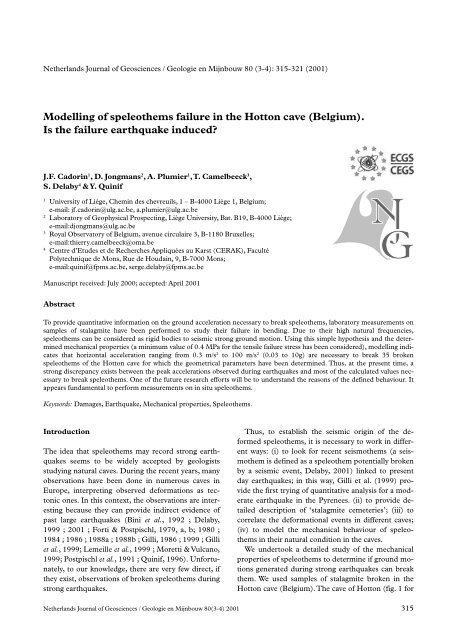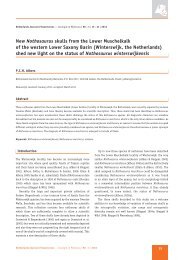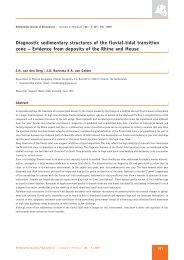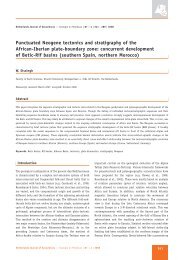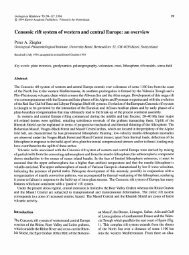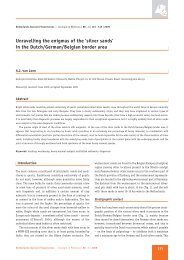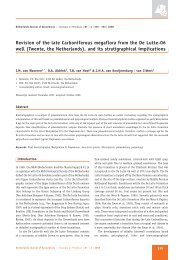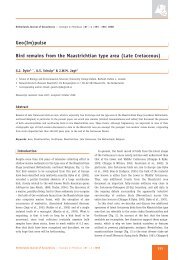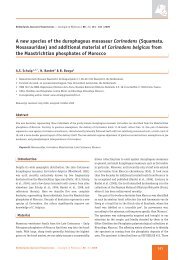Modelling of speleothems failure in the Hotton cave - Netherlands ...
Modelling of speleothems failure in the Hotton cave - Netherlands ...
Modelling of speleothems failure in the Hotton cave - Netherlands ...
You also want an ePaper? Increase the reach of your titles
YUMPU automatically turns print PDFs into web optimized ePapers that Google loves.
Ne<strong>the</strong>rlands Journal <strong>of</strong> Geosciences / Geologie en Mijnbouw 80 (3-4): 315-321 (2001)<br />
<strong>Modell<strong>in</strong>g</strong> <strong>of</strong> <strong>speleo<strong>the</strong>ms</strong> <strong>failure</strong> <strong>in</strong> <strong>the</strong> <strong>Hotton</strong> <strong>cave</strong> (Belgium).<br />
Is <strong>the</strong> <strong>failure</strong> earthquake <strong>in</strong>duced?<br />
J.F. Cador<strong>in</strong> 1 , D. Jongmans 2 , A. Plumier 1 ,T. Camelbeeck 3 ,<br />
S. Delaby 4 & Y. Qu<strong>in</strong>if<br />
1 University <strong>of</strong> Liège, Chem<strong>in</strong> des chevreuils, 1 – B-4000 Liège 1, Belgium;<br />
e-mail: jf.cador<strong>in</strong>@ulg.ac.be, a.plumier@ulg.ac.be<br />
2 Laboratory <strong>of</strong> Geophysical Prospect<strong>in</strong>g, Liège University, Bat. B19, B-4000 Liège;<br />
e-mail:djongmans@ulg.ac.be<br />
3 Royal Observatory <strong>of</strong> Belgium, avenue circulaire 3, B-1180 Bruxelles;<br />
e-mail:thierry.camelbeeck@oma.be<br />
4 Centre d’Etudes et de Recherches Appliquées au Karst (CERAK), Faculté<br />
Polytechnique de Mons, Rue de Houda<strong>in</strong>, 9, B-7000 Mons;<br />
e-mail:qu<strong>in</strong>if@fpms.ac.be, serge.delaby@fpms.ac.be<br />
Manuscript received: July 2000; accepted: April 2001<br />
Abstract<br />
To provide quantitative <strong>in</strong>formation on <strong>the</strong> ground acceleration necessary to break <strong>speleo<strong>the</strong>ms</strong>, laboratory measurements on<br />
samples <strong>of</strong> stalagmite have been performed to study <strong>the</strong>ir <strong>failure</strong> <strong>in</strong> bend<strong>in</strong>g. Due to <strong>the</strong>ir high natural frequencies,<br />
<strong>speleo<strong>the</strong>ms</strong> can be considered as rigid bodies to seismic strong ground motion. Us<strong>in</strong>g this simple hypo<strong>the</strong>sis and <strong>the</strong> determ<strong>in</strong>ed<br />
mechanical properties (a m<strong>in</strong>imum value <strong>of</strong> 0.4 MPa for <strong>the</strong> tensile <strong>failure</strong> stress has been considered), modell<strong>in</strong>g <strong>in</strong>dicates<br />
that horizontal acceleration rang<strong>in</strong>g from 0.3 m/s 2 to 100 m/s 2 (0.03 to 10g) are necessary to break 35 broken<br />
<strong>speleo<strong>the</strong>ms</strong> <strong>of</strong> <strong>the</strong> <strong>Hotton</strong> <strong>cave</strong> for which <strong>the</strong> geometrical parameters have been determ<strong>in</strong>ed. Thus, at <strong>the</strong> present time, a<br />
strong discrepancy exists between <strong>the</strong> peak accelerations observed dur<strong>in</strong>g earthquakes and most <strong>of</strong> <strong>the</strong> calculated values necessary<br />
to break <strong>speleo<strong>the</strong>ms</strong>. One <strong>of</strong> <strong>the</strong> future research efforts will be to understand <strong>the</strong> reasons <strong>of</strong> <strong>the</strong> def<strong>in</strong>ed behaviour. It<br />
appears fundamental to perform measurements on <strong>in</strong> situ <strong>speleo<strong>the</strong>ms</strong>.<br />
Keywords: Damages, Earthquake, Mechanical properties, Speleo<strong>the</strong>ms.<br />
Introduction<br />
The idea that <strong>speleo<strong>the</strong>ms</strong> may record strong earthquakes<br />
seems to be widely accepted by geologists<br />
study<strong>in</strong>g natural <strong>cave</strong>s. Dur<strong>in</strong>g <strong>the</strong> recent years, many<br />
observations have been done <strong>in</strong> numerous <strong>cave</strong>s <strong>in</strong><br />
Europe, <strong>in</strong>terpret<strong>in</strong>g observed deformations as tectonic<br />
ones. In this context, <strong>the</strong> observations are <strong>in</strong>terest<strong>in</strong>g<br />
because <strong>the</strong>y can provide <strong>in</strong>direct evidence <strong>of</strong><br />
past large earthquakes (B<strong>in</strong>i et al., 1992 ; Delaby,<br />
1999 ; 2001 ; Forti & Postpischl, 1979, a, b; 1980 ;<br />
1984 ; 1986 ; 1988a ; 1988b ; Gilli, 1986 ; 1999 ; Gilli<br />
et al., 1999; Lemeille et al., 1999 ; Moretti & Vulcano,<br />
1999; Postpischl et al., 1991 ; Qu<strong>in</strong>if, 1996). Unfortunately,<br />
to our knowledge, <strong>the</strong>re are very few direct, if<br />
<strong>the</strong>y exist, observations <strong>of</strong> broken <strong>speleo<strong>the</strong>ms</strong> dur<strong>in</strong>g<br />
strong earthquakes.<br />
Thus, to establish <strong>the</strong> seismic orig<strong>in</strong> <strong>of</strong> <strong>the</strong> deformed<br />
<strong>speleo<strong>the</strong>ms</strong>, it is necessary to work <strong>in</strong> different<br />
ways: (i) to look for recent seismo<strong>the</strong>ms (a seismo<strong>the</strong>m<br />
is def<strong>in</strong>ed as a speleo<strong>the</strong>m potentially broken<br />
by a seismic event, Delaby, 2001) l<strong>in</strong>ked to present<br />
day earthquakes; <strong>in</strong> this way, Gilli et al. (1999) provide<br />
<strong>the</strong> first try<strong>in</strong>g <strong>of</strong> quantitative analysis for a moderate<br />
earthquake <strong>in</strong> <strong>the</strong> Pyrenees. (ii) to provide detailed<br />
description <strong>of</strong> ‘stalagmite cemeteries’; (iii) to<br />
correlate <strong>the</strong> deformational events <strong>in</strong> different <strong>cave</strong>s;<br />
(iv) to model <strong>the</strong> mechanical behaviour <strong>of</strong> <strong>speleo<strong>the</strong>ms</strong><br />
<strong>in</strong> <strong>the</strong>ir natural condition <strong>in</strong> <strong>the</strong> <strong>cave</strong>s.<br />
We undertook a detailed study <strong>of</strong> <strong>the</strong> mechanical<br />
properties <strong>of</strong> <strong>speleo<strong>the</strong>ms</strong> to determ<strong>in</strong>e if ground motions<br />
generated dur<strong>in</strong>g strong earthquakes can break<br />
<strong>the</strong>m. We used samples <strong>of</strong> stalagmite broken <strong>in</strong> <strong>the</strong><br />
<strong>Hotton</strong> <strong>cave</strong> (Belgium).The <strong>cave</strong> <strong>of</strong> <strong>Hotton</strong> (fig. 1 for<br />
Ne<strong>the</strong>rlands Journal <strong>of</strong> Geosciences / Geologie en Mijnbouw 80(3-4) 2001 315
Fig. 1. Localisation <strong>of</strong> <strong>Hotton</strong>.<br />
its location) is an ideal study site. It develops <strong>in</strong> Givetian<br />
limestone with sub-vertical, <strong>in</strong>verse layer<strong>in</strong>g <strong>of</strong><br />
constant orientation. The <strong>cave</strong> is <strong>the</strong> down-stream<br />
part <strong>of</strong> one <strong>of</strong> <strong>the</strong> most impressive s<strong>in</strong>k – resurgence<br />
system <strong>in</strong> Belgium. The <strong>cave</strong> <strong>of</strong> <strong>Hotton</strong> was discovered<br />
<strong>in</strong> a quarry <strong>in</strong> 1958 and was immediately closed<br />
for protection. At <strong>the</strong> present time, <strong>the</strong> <strong>cave</strong> develops<br />
5 km <strong>of</strong> galleries. Up-stream, <strong>the</strong> galleries are preserved<br />
from human depredation by a number <strong>of</strong><br />
doors and sumps.<br />
The <strong>cave</strong> <strong>of</strong> <strong>Hotton</strong> is a typical example <strong>of</strong> a multilevel<br />
<strong>cave</strong>. The different levels <strong>of</strong> <strong>the</strong> <strong>cave</strong> are l<strong>in</strong>ked<br />
with <strong>the</strong> evolution <strong>of</strong> <strong>the</strong> Our<strong>the</strong> River.The upper level,<br />
older, shows deformed and broken <strong>speleo<strong>the</strong>ms</strong>.<br />
Delaby (2000) provides field evidence that <strong>the</strong> cause<br />
<strong>of</strong> <strong>the</strong> <strong>speleo<strong>the</strong>ms</strong> break or deformation could be <strong>of</strong><br />
seismic orig<strong>in</strong>. In this study, we exam<strong>in</strong>ed candle<br />
shaped stalagmites hav<strong>in</strong>g particular morphological<br />
and environmental characteristics. The ideal shape <strong>of</strong><br />
<strong>the</strong> stalagmite is a cyl<strong>in</strong>der with a ra<strong>the</strong>r constant diameter<br />
and with <strong>the</strong> gravity centre above <strong>the</strong> base<br />
(contact po<strong>in</strong>t) <strong>of</strong> <strong>the</strong> stalagmite. The pieces <strong>of</strong> <strong>the</strong><br />
broken stalagmite must be soldered and <strong>the</strong> stalagmite<br />
must have grown on a stable substratum.<br />
The static and dynamic behaviours <strong>of</strong> <strong>the</strong> speleo<strong>the</strong>m<br />
materials have been firstly studied by laboratory<br />
test<strong>in</strong>g. With <strong>the</strong> help <strong>of</strong> <strong>the</strong> material properties and<br />
Fig. 2. Apparatus used for <strong>the</strong> bend<strong>in</strong>g tests.<br />
<strong>the</strong> <strong>in</strong>-site geometry measurement, <strong>the</strong> maximum acceleration<br />
<strong>of</strong> <strong>the</strong> earthquake which could have caused<br />
<strong>the</strong> speleo<strong>the</strong>m <strong>failure</strong> has been evaluated.<br />
Mechanical properties <strong>of</strong> <strong>speleo<strong>the</strong>ms</strong><br />
Various laboratory tests have been performed on <strong>the</strong><br />
<strong>speleo<strong>the</strong>ms</strong> taken <strong>in</strong> <strong>the</strong> <strong>Hotton</strong> <strong>cave</strong> <strong>in</strong> order to determ<strong>in</strong>e<br />
<strong>the</strong>ir mechanical properties.<br />
The mean value <strong>of</strong> <strong>the</strong> specific mass ρ <strong>of</strong> <strong>the</strong><br />
<strong>speleo<strong>the</strong>ms</strong> is 2500 kg/m 3 . The Young’s modulus E is<br />
22000 MPa. The variation around <strong>the</strong>se values is<br />
weak.The resistance <strong>in</strong> simple compression is between<br />
15 and 38 MPa, while <strong>the</strong> tensile resistance obta<strong>in</strong>ed<br />
from Brazilian tests is rang<strong>in</strong>g between 1.5 and 2 MPa.<br />
The <strong>failure</strong> tensile stress <strong>of</strong> <strong>the</strong> <strong>speleo<strong>the</strong>ms</strong> has also<br />
been evaluated by static and dynamic bend<strong>in</strong>g tests<br />
on some specimens <strong>of</strong> <strong>speleo<strong>the</strong>ms</strong> and one fatigue<br />
test has been made as well. Figure 2 and Photo 2<br />
show a schematic view <strong>of</strong> <strong>the</strong> test<strong>in</strong>g apparatus used<br />
for <strong>the</strong> bend<strong>in</strong>g tests.<br />
Seven static bend<strong>in</strong>g tests have been performed on<br />
specimens sampled from 4 broken <strong>speleo<strong>the</strong>ms</strong> (Photo<br />
1 shows <strong>speleo<strong>the</strong>ms</strong> n°5891, broken <strong>in</strong> three<br />
parts, sample 5891.1, 5891.2 and 5891.3). The tensile<br />
<strong>failure</strong> stresses deduced from <strong>the</strong>se tests are<br />
shown <strong>in</strong> Table 1.<br />
The mean value and <strong>the</strong> standard deviation <strong>of</strong><br />
<strong>the</strong>se tensile <strong>failure</strong> stresses are 1.94 and 0.71 MPa,<br />
Table 1.Tensile <strong>failure</strong> stresses from static bend<strong>in</strong>g tests.<br />
Sample Failure stress [MPa]<br />
A1 0.64<br />
A3.1 2.73<br />
A3.2 2.75<br />
B3.1 2.10<br />
B3.2 1.44<br />
5891.1 2.32<br />
5891.2 1.63<br />
5891.3 1.91<br />
50mm<br />
L<br />
Plaster<br />
Steel plate<br />
Specimen<br />
316 Ne<strong>the</strong>rlands Journal <strong>of</strong> Geosciences / Geologie en Mijnbouw / 80(3-4) 2001<br />
P
espectively, with a m<strong>in</strong>imum value <strong>of</strong> 0.64 MPa. In a<br />
second phase, <strong>the</strong> effect <strong>of</strong> <strong>the</strong> load velocity has been<br />
studied by compar<strong>in</strong>g <strong>the</strong> results <strong>of</strong> 3 static tests (with<br />
a displacement rate <strong>of</strong> 5 10 -4 mm/s) and 5 dynamic<br />
tests (with a displacement rate <strong>of</strong> 5 mm/s) on two<br />
<strong>speleo<strong>the</strong>ms</strong>. The value <strong>of</strong> 5 mm/s corresponds to a<br />
displacement rate which can reasonably be expected<br />
dur<strong>in</strong>g an earthquake. The tensile <strong>failure</strong> stress deduced<br />
from <strong>the</strong>se tests, as well as <strong>the</strong> mean values, are<br />
shown <strong>in</strong> Table 2.<br />
Table 2: Dynamic bend<strong>in</strong>g tests.<br />
Sample Displacement rate Failure stress<br />
[mm/s] [MPa]<br />
6186B/1 5 10 -4 (1) 0.60<br />
6186C/1 5 10 -4 (1) 0.42<br />
Mean -static (6186) : 0.51<br />
6186A 5 0.81<br />
6186A/2 5 0.82<br />
6186B/2 5 0.69<br />
6186C 5 0.82<br />
Mean -dynamic (6186): 0.79<br />
6187/1 5 10 -4 (1) 1.29<br />
6187 5 1.49<br />
(1) static tests are <strong>in</strong> italic.<br />
One fatigue test has also been performed on a sample<br />
from <strong>the</strong> speleo<strong>the</strong>m n°6186. Consider<strong>in</strong>g a <strong>failure</strong><br />
stress <strong>of</strong> 0.7 MPa, <strong>the</strong> <strong>failure</strong> load has been estimated<br />
to F u=2400 N. The mean value <strong>of</strong> <strong>the</strong> load is<br />
<strong>the</strong>n set to half <strong>of</strong> <strong>the</strong> estimated <strong>failure</strong> load <strong>of</strong> <strong>the</strong><br />
speleo<strong>the</strong>m <strong>in</strong> bend<strong>in</strong>g, i.e. F mean=1200 N. The force<br />
variation is set to 80 percent <strong>of</strong> <strong>the</strong> estimated <strong>failure</strong><br />
load, i.e. ∆F=2000 N. The load is applied with a frequency<br />
<strong>of</strong> 1 Hz (1 cycle per second) considered to<br />
represent a real earthquake. Figure 3 shows <strong>the</strong> applied<br />
load function <strong>of</strong> time. The <strong>failure</strong> <strong>of</strong> <strong>the</strong> specimen<br />
has been atta<strong>in</strong>ed after 1411 cycles, a number<br />
which is much higher than expected dur<strong>in</strong>g one or<br />
several earthquakes.<br />
Conclusions on <strong>the</strong> mechanical properties<br />
The <strong>failure</strong> tensile stress values obta<strong>in</strong>ed by bend<strong>in</strong>g<br />
<strong>of</strong> broken <strong>speleo<strong>the</strong>ms</strong> from <strong>the</strong> <strong>Hotton</strong> <strong>cave</strong> range<br />
between 0.4 and 2.7 MPa. However, <strong>the</strong> range on <strong>the</strong><br />
results obta<strong>in</strong>ed on samples com<strong>in</strong>g from <strong>the</strong> same<br />
speleo<strong>the</strong>m is weaker.<br />
The tensile stress obta<strong>in</strong>ed <strong>in</strong> dynamic tests is<br />
slightly higher <strong>the</strong>n <strong>in</strong> static tests but it has a lower <strong>in</strong>-<br />
∆F F MEAN<br />
APPLIED LOAD (N)<br />
N = 1 N = 2 N = 3 N = ...<br />
0 1 2 3 4 5<br />
TIME (s)<br />
fluence <strong>the</strong>n <strong>the</strong> scatter<strong>in</strong>g <strong>of</strong> <strong>the</strong> static tensile resistance<br />
<strong>of</strong> different <strong>speleo<strong>the</strong>ms</strong>.<br />
The test fatigue resistance is high i.e. more number<br />
<strong>of</strong> cycles <strong>the</strong>n an actual speleo<strong>the</strong>m dur<strong>in</strong>g one or<br />
several real earthquakes.<br />
Estimation <strong>of</strong> <strong>the</strong> ground accelleration lead<strong>in</strong>g<br />
to <strong>the</strong> <strong>failure</strong> <strong>of</strong> broken <strong>speleo<strong>the</strong>ms</strong> <strong>in</strong> <strong>Hotton</strong><br />
Cave<br />
The geometry <strong>of</strong> 34 broken <strong>speleo<strong>the</strong>ms</strong> <strong>in</strong> <strong>the</strong> <strong>Hotton</strong><br />
<strong>cave</strong> have been reconstituted (Delaby, 2001). The<br />
available data (Table 3) are <strong>the</strong> height H <strong>of</strong> <strong>the</strong> reconstituted<br />
fallen part and <strong>the</strong> diameter D <strong>of</strong> <strong>the</strong> <strong>failure</strong><br />
section which is considered circular. The <strong>speleo<strong>the</strong>ms</strong><br />
are considered as cantilever beams <strong>of</strong> height H and<br />
with a constant circular section <strong>of</strong> diameter D (Figures<br />
4 and 5).<br />
Ne<strong>the</strong>rlands Journal <strong>of</strong> Geosciences / Geologie en Mijnbouw 80(3-4) 2001 317<br />
0<br />
F U<br />
Fig. 3. Applied load function <strong>of</strong> time <strong>in</strong> <strong>the</strong> fatigue test.<br />
Failure<br />
section<br />
Ground<br />
motion<br />
H<br />
F = ma<br />
Fig. 4. Elevation view <strong>of</strong> a speleo<strong>the</strong>m and model.<br />
D D<br />
Fig. 5. Failure section and model.<br />
H/2
Photo 1. Speleo<strong>the</strong>m n°5891 (samples 5891.1, 5891.2 and 5891.3). Photo 2. Bend<strong>in</strong>g test apparatus.<br />
The parameters considered <strong>in</strong> <strong>the</strong> computations are:<br />
H Height <strong>of</strong> <strong>the</strong> speleo<strong>the</strong>m over <strong>the</strong> <strong>failure</strong> section<br />
[m]<br />
D In-site measured diameter <strong>of</strong> <strong>the</strong> <strong>failure</strong> section<br />
[m]<br />
Photo 3. A <strong>failure</strong> section after<br />
bend<strong>in</strong>g test.<br />
r Radius <strong>of</strong> <strong>the</strong> <strong>failure</strong> section [m]<br />
S Area <strong>of</strong> <strong>the</strong> <strong>failure</strong> section [m 3 ]<br />
E Young’s modulus <strong>of</strong> <strong>the</strong> speleo<strong>the</strong>m material<br />
[N/m 3 ]<br />
I Inertia <strong>of</strong> <strong>the</strong> <strong>failure</strong> section [m 4 ]<br />
318 Ne<strong>the</strong>rlands Journal <strong>of</strong> Geosciences / Geologie en Mijnbouw / 80(3-4) 2001
V Volume <strong>of</strong> <strong>the</strong> speleo<strong>the</strong>m [m3 ]<br />
m Mass <strong>of</strong> <strong>the</strong> speleo<strong>the</strong>m [kg]<br />
F Inertia forces applied on <strong>the</strong> speleo<strong>the</strong>m at <strong>the</strong><br />
mid height [N]<br />
M Bend<strong>in</strong>g moment due to <strong>in</strong>ertia forces <strong>in</strong> <strong>the</strong> <strong>failure</strong><br />
section [Nm]<br />
σu Failure stress <strong>in</strong> tension [MPa]<br />
ag Peak ground acceleration [m/s2 ]<br />
Fundamental frequency <strong>of</strong> <strong>the</strong> <strong>speleo<strong>the</strong>ms</strong> [Hz]<br />
f P<br />
The fundamental frequency <strong>of</strong> a cantilever beam is<br />
given by <strong>the</strong> follow<strong>in</strong>g equation:<br />
f P<br />
1<br />
=<br />
π<br />
3ED<br />
2<br />
16ρH<br />
4<br />
(1)<br />
The natural frequency <strong>of</strong> <strong>the</strong> <strong>speleo<strong>the</strong>ms</strong> are <strong>the</strong>n<br />
between 20 Hz and 6815 Hz (Table 3). As <strong>the</strong> energy<br />
<strong>of</strong> an earthquake is essentially released with<strong>in</strong> a frequency<br />
range lower than 20 Hz, <strong>the</strong> <strong>speleo<strong>the</strong>ms</strong> can<br />
be considered as rigid bodies <strong>in</strong> a first approximation<br />
and submitted to <strong>the</strong> ground acceleration without<br />
amplification.<br />
The ground acceleration that leads to <strong>the</strong> <strong>failure</strong> <strong>of</strong><br />
a speleo<strong>the</strong>m as a function <strong>of</strong> its geometry and <strong>failure</strong><br />
stress is obta<strong>in</strong>ed through <strong>the</strong> follow<strong>in</strong>g relationships:<br />
Mr H 4<br />
σ u = = F<br />
I 2 3<br />
πr<br />
2H<br />
= mag<br />
3<br />
πr<br />
H<br />
= 2ρ<br />
r<br />
D<br />
a g σ u<br />
ρH 2<br />
1<br />
=<br />
4<br />
(3)<br />
(2)<br />
(3)<br />
If a <strong>failure</strong> stress <strong>of</strong> 0.4 MPa is considered <strong>in</strong> <strong>the</strong><br />
calculation, <strong>the</strong> acceleration needed to break <strong>the</strong><br />
<strong>speleo<strong>the</strong>ms</strong> by flexion are between 2m/s 2 and<br />
667m/s 2 (Table 3). This ground acceleration decrease<br />
with an <strong>in</strong>creas<strong>in</strong>g H/D ratio. Values lower <strong>the</strong>n 10<br />
m/s 2 are obta<strong>in</strong>ed for H/D ratio higher <strong>the</strong>n around 8.<br />
The highest values <strong>of</strong> ground accelerations are obta<strong>in</strong>ed<br />
for very small dimensions <strong>speleo<strong>the</strong>ms</strong>.<br />
Discussion on <strong>the</strong> mechanical model<br />
The geometry <strong>of</strong> <strong>the</strong> broken <strong>speleo<strong>the</strong>ms</strong> <strong>in</strong> <strong>the</strong> <strong>Hotton</strong><br />
<strong>cave</strong> was def<strong>in</strong>ed by only two parameters; <strong>the</strong><br />
length <strong>of</strong> <strong>the</strong> reconstituted <strong>speleo<strong>the</strong>ms</strong> (some <strong>of</strong><br />
<strong>the</strong>m were broken <strong>in</strong> 3 or 4 parts) and one diameter<br />
<strong>of</strong> <strong>the</strong> <strong>failure</strong> section.The ma<strong>in</strong> hypo<strong>the</strong>ses <strong>of</strong> <strong>the</strong> previous<br />
calculations are that <strong>the</strong> cross sections <strong>of</strong> <strong>the</strong><br />
speleo<strong>the</strong>m are circular with a diameter D measured<br />
<strong>in</strong> <strong>the</strong> <strong>cave</strong> and that this section is constant along <strong>the</strong><br />
height <strong>of</strong> <strong>the</strong> speleo<strong>the</strong>m. It is obvious that <strong>the</strong> cross<br />
sections along <strong>the</strong> height <strong>of</strong> <strong>the</strong> speleo<strong>the</strong>m exhibit a<br />
non-circular shape (Figure 2 and Photo 3). A more<br />
2<br />
a<br />
g<br />
Table 3. Dimensions <strong>of</strong> broken <strong>speleo<strong>the</strong>ms</strong> <strong>in</strong> <strong>the</strong> <strong>Hotton</strong> <strong>cave</strong>,<br />
<strong>the</strong>ir natural frequency (f) and <strong>the</strong> ground acceleration (a) necessary<br />
for <strong>the</strong>ir rupture.<br />
Nº H D H/D m a f<br />
m m kg m/s Hz<br />
1 0.520 0.27 1.9 74.432 40 408<br />
2 0.180 0.10 1.8 3.534 123 1262<br />
3 0.100 0.08 1.3 1.257 320 3271<br />
4 0.280 0.06 4.7 1.979 31 313<br />
5 0.260 0.11 2.4 6.177 65 665<br />
6 0.315 0.06 5.3 2.227 24 247<br />
7 0.300 0.06 5.0 2.121 27 273<br />
8 0.140 0.03 4.7 0.247 61 626<br />
9 0.160 0.08 2.0 2.011 125 1278<br />
10 0.500 0.06 8.3 3.534 10 98<br />
11 0.570 0.08 7.6 6.295 9 94<br />
12 0.240 0.11 2.2 5.702 76 781<br />
13 0.190 0.06 3.2 1.343 66 680<br />
14 0.070 0.08 0.9 0.880 653 6676<br />
15 0.060 0.06 1.0 0.424 667 6815<br />
16 0.350 0.10 3.5 6.872 33 334<br />
17 0.230 0.07 3.3 2.213 53 541<br />
18 0.160 0.07 2.3 1.539 109 1118<br />
19 0.310 0.09 3.4 4.930 37 383<br />
20 0.150 0.10 1.5 2.945 178 1817<br />
21 0.250 0.08 3.1 3.142 51 523<br />
22 0.350 0.27 1.3 50.099 88 901<br />
23 0.400 0.07 5.7 3.848 18 179<br />
24 0.360 0.25 1.4 44.179 77 789<br />
25 0.210 0.07 3.0 2.020 63 649<br />
26 0.260 0.06 4.3 1.838 36 363<br />
27 0.180 0.15 1.2 7.952 185 1893<br />
28 0.350 0.10 3.5 6.872 33 334<br />
29 0.250 0.10 2.6 4.430 61 621<br />
30 0.200 0.07 2.9 1.924 70 716<br />
31 0.280 0.11 2.7 6.061 54 548<br />
32 0.540 0.07 8.3 4.480 9 91<br />
33 0.400 0.10 4.0 7.854 25 256<br />
34 1.000 0.05 20.0 4.909 2 20<br />
realistic model can be built to estimate <strong>the</strong> <strong>in</strong>fluence<br />
<strong>of</strong> <strong>the</strong>se geometrical uncerta<strong>in</strong>ties.<br />
Now, we consider that <strong>the</strong> <strong>failure</strong> cross section <strong>of</strong><br />
<strong>the</strong> speleo<strong>the</strong>m is circular <strong>of</strong> diameter Du which is <strong>the</strong><br />
real dimension that <strong>in</strong>fluences <strong>the</strong> resistance <strong>of</strong> <strong>the</strong><br />
<strong>failure</strong> section. Du is used to calculate <strong>the</strong> resistance<br />
<strong>of</strong> <strong>the</strong> speleo<strong>the</strong>m. The geometry <strong>of</strong> <strong>the</strong> speleo<strong>the</strong>m is<br />
modelled as a cyl<strong>in</strong>der <strong>of</strong> height H (<strong>the</strong> measured<br />
height from <strong>the</strong> fallen part <strong>of</strong> <strong>the</strong> speleo<strong>the</strong>m) and <strong>of</strong><br />
diameter Dmean (Figure 7). The diameter is fixed so<br />
that <strong>the</strong> cyl<strong>in</strong>der has <strong>the</strong> same mass as <strong>the</strong> real<br />
speleo<strong>the</strong>m.<br />
We have <strong>the</strong>n:<br />
Du ,ru Diameter (radius) <strong>of</strong> <strong>the</strong> <strong>failure</strong> section<br />
[m]<br />
Dmean ,rmean Mean diameter (radius) <strong>of</strong> <strong>the</strong> speleo<strong>the</strong>m<br />
[m]<br />
Ne<strong>the</strong>rlands Journal <strong>of</strong> Geosciences / Geologie en Mijnbouw 80(3-4) 2001 319
While <strong>in</strong> <strong>the</strong> previous case <strong>the</strong> centre <strong>of</strong> gravity <strong>of</strong><br />
<strong>the</strong> broken part from <strong>the</strong> speleo<strong>the</strong>m was considered<br />
at mid-height, ano<strong>the</strong>r case was envisaged with <strong>the</strong><br />
centre <strong>of</strong> gravity at αH from bottom. α is a non-dimensional<br />
parameter, rang<strong>in</strong>g from zero (<strong>failure</strong> section<br />
level) to one (top <strong>of</strong> <strong>the</strong> speleo<strong>the</strong>m). This position<br />
affects <strong>the</strong> value <strong>of</strong> <strong>the</strong> bend<strong>in</strong>g moment <strong>in</strong> <strong>the</strong><br />
<strong>failure</strong> section when <strong>the</strong> speleo<strong>the</strong>m is submitted to a<br />
ground movement.<br />
Failure<br />
section<br />
Ground<br />
motion<br />
H<br />
F = ma<br />
Fig. 6. Elevation view <strong>of</strong> a speleo<strong>the</strong>m and model.<br />
D<br />
Du<br />
Measured diameter Resistance + geometry<br />
Fig. 7. Failure section and cross section models.<br />
αH<br />
Dmean<br />
Local geometrical imperfections can lead to some<br />
stress concentrations. The value <strong>of</strong> <strong>the</strong> stress concentration<br />
factor ψ, ratio between <strong>the</strong> maximum stress<br />
σ max and <strong>the</strong> mean stress σ m, depends on <strong>the</strong> type <strong>of</strong><br />
notch. We will not consider <strong>the</strong> case <strong>of</strong> an already <strong>in</strong>itiated<br />
crack, for which ψ can be as high as 10 or 20,<br />
but simply <strong>the</strong> notch effect correspond<strong>in</strong>g to an irregular<br />
surface aspect which is commonly observed. It is<br />
similar to a semicircular notch (<strong>of</strong> radius ρ) hav<strong>in</strong>g<br />
<strong>the</strong> shape shown <strong>in</strong> Figure 8, for which tension tests<br />
on mortar specimens have <strong>in</strong>dicated a value around 2<br />
[Massonnet 1962].<br />
Consider<strong>in</strong>g <strong>the</strong> stress concentration factor, <strong>the</strong><br />
new position <strong>of</strong> <strong>the</strong> <strong>in</strong>ertia forces and <strong>the</strong> two different<br />
diameters D u and D mean <strong>of</strong> <strong>the</strong> cross section, it is<br />
possible to rewrite <strong>the</strong> formulas (2) and (3):<br />
Mru<br />
σ u = ψ<br />
I<br />
4<br />
= ψFαH<br />
3<br />
πru<br />
= ψma<br />
2 2<br />
H rmean<br />
*<br />
= 4αρ ψa<br />
3 g<br />
r<br />
u<br />
+<br />
*<br />
g<br />
4αH<br />
πr<br />
3<br />
u<br />
(4)<br />
(5)<br />
The ratio <strong>of</strong> <strong>the</strong> ground accelerations that leads to<br />
<strong>the</strong> <strong>failure</strong> <strong>of</strong> a speleo<strong>the</strong>m obta<strong>in</strong>ed with <strong>the</strong> two different<br />
models is :<br />
(6)<br />
The diameter variation <strong>of</strong> <strong>the</strong> sections along <strong>the</strong><br />
speleo<strong>the</strong>m can reasonably be estimated from 20% to<br />
30%. The diameter which is taken <strong>in</strong>to account to<br />
evaluate <strong>the</strong> resistance can vary about 10% around<br />
<strong>the</strong> measured value. And <strong>the</strong> level <strong>of</strong> <strong>the</strong> resultant <strong>in</strong>ertia<br />
force can be estimated to be between 0.3H and<br />
0.7H.<br />
From <strong>the</strong> formula (6), we obta<strong>in</strong> a ratio<br />
Tak<strong>in</strong>g <strong>in</strong>to account <strong>the</strong> geometry uncerta<strong>in</strong>ties<br />
and a possible stress concentration, <strong>the</strong> accelerations<br />
needed to break <strong>the</strong> <strong>speleo<strong>the</strong>ms</strong> by flexion can thus<br />
decrease to values between 0.3 m/s 2 and 100 m/s 2 .<br />
Conclusions<br />
The ma<strong>in</strong> conclusion <strong>of</strong> our mechanical tests and<br />
modell<strong>in</strong>g results is that horizontal acceleration values<br />
needed to break <strong>the</strong> <strong>speleo<strong>the</strong>ms</strong> <strong>of</strong> <strong>Hotton</strong> <strong>cave</strong><br />
are very scattered from 0.03 g to 10 g. Even if low accelerations<br />
were detected, globally <strong>the</strong> values are<br />
much higher than <strong>the</strong> peak ground acceleration expected<br />
from earthquakes. If <strong>the</strong> <strong>failure</strong> happens due<br />
320 Ne<strong>the</strong>rlands Journal <strong>of</strong> Geosciences / Geologie en Mijnbouw / 80(3-4) 2001<br />
ρ<br />
P<br />
σmax<br />
n<br />
P<br />
ρ<br />
σm<br />
3<br />
Du<br />
2<br />
mean<br />
* 1<br />
1<br />
ag =<br />
σ<br />
8<br />
2<br />
αρD<br />
H ψ<br />
a<br />
*<br />
g<br />
a<br />
a<br />
g<br />
*<br />
g<br />
a<br />
g<br />
⎛ Du<br />
⎞<br />
⎜ ⎟<br />
0.<br />
5 ⎝ D 1<br />
=<br />
⎠<br />
α<br />
2<br />
⎛ D ⎞ ψ<br />
mean<br />
⎜ ⎟<br />
⎝ D ⎠<br />
0.<br />
5<br />
=<br />
0.<br />
7<br />
Fig. 8. Shape <strong>of</strong> notch considered <strong>in</strong> <strong>the</strong> fatigue<br />
model<br />
3<br />
3 ( 0.<br />
9)<br />
1 1<br />
= .<br />
2 ( 1.<br />
3)<br />
2 6.<br />
5<br />
u
to shear and not bend<strong>in</strong>g, <strong>the</strong> acceleration required<br />
would even be stronger. If vertical accelerations had<br />
been considered, <strong>the</strong> horizontal ones would have been<br />
reduced at most by 30% to 50% but still <strong>the</strong> conclusions<br />
would rema<strong>in</strong> <strong>the</strong> same.<br />
These results are obta<strong>in</strong>ed consider<strong>in</strong>g a tensile<br />
<strong>failure</strong> stress <strong>of</strong> 0.4 MPa <strong>in</strong> our computations, which<br />
is <strong>the</strong> m<strong>in</strong>imum measured resistance. This measurement<br />
was however determ<strong>in</strong>ed on stalagmite samples<br />
which were already broken <strong>in</strong>side <strong>the</strong> <strong>Hotton</strong> <strong>cave</strong>. It<br />
is reasonable to consider that <strong>the</strong> resistance values at<br />
<strong>the</strong> break could be lower than 0.4 MPa. Moreover,<br />
<strong>the</strong> <strong>speleo<strong>the</strong>ms</strong> are not cyl<strong>in</strong>drical and <strong>the</strong> section<br />
variations could lead to a decrease <strong>in</strong> <strong>the</strong> acceleration<br />
values required to break <strong>the</strong> <strong>speleo<strong>the</strong>ms</strong>.<br />
Computations showed that <strong>the</strong>se effects can reduce<br />
<strong>the</strong> accelerations required for <strong>failure</strong> by a factor <strong>of</strong><br />
6.5, which is not enough to expla<strong>in</strong> <strong>the</strong> disagreement<br />
between computed accelerations and expected earthquake<br />
accelerations for all <strong>the</strong> broken <strong>speleo<strong>the</strong>ms</strong> <strong>in</strong><br />
<strong>Hotton</strong> <strong>cave</strong>.<br />
The understand<strong>in</strong>g <strong>of</strong> speleo<strong>the</strong>m fall <strong>in</strong> <strong>Hotton</strong><br />
<strong>cave</strong> requires several aspects to be clarified. One<br />
problem can be <strong>the</strong> adequacy <strong>of</strong> <strong>the</strong> modell<strong>in</strong>g used<br />
to represent <strong>the</strong> dynamic behaviour <strong>of</strong> <strong>speleo<strong>the</strong>ms</strong>.<br />
Discont<strong>in</strong>uities <strong>in</strong>side <strong>the</strong> material like cleavages ,<br />
stratifications,… play also a role dur<strong>in</strong>g <strong>the</strong> speleo<strong>the</strong>m<br />
deformation. Future research efforts should be<br />
focused on <strong>in</strong>-situ measurements <strong>of</strong> <strong>the</strong> response <strong>of</strong><br />
<strong>speleo<strong>the</strong>ms</strong> to vibrations and on <strong>the</strong> study <strong>of</strong> <strong>the</strong><br />
rupture mechanism at <strong>the</strong> gra<strong>in</strong> size.<br />
Acknowledgement<br />
This work has been supported by <strong>the</strong> FRFC Belgium<br />
project 2450297.<br />
References<br />
B<strong>in</strong>i A., Qu<strong>in</strong>if Y., Sules O., Uggeri A., 1992. Evidences de tectonique<br />
récente dans les grottes du M. Campo de Fiori (Lombardie,<br />
Italie). Karstologia 19 : 23-30.<br />
Delaby S., 1999. Etude statistique de l’enregistrement paléosismique<br />
par les spéléothèmes. L’exemple de la Grotte de <strong>Hotton</strong><br />
(Belgique). ‘Karst 99’. Etudes de géographie physique, travaux<br />
1999 – Suppl.nE XXVIII, CAGEP, Université de Provence : 73-<br />
76.<br />
Delaby S., 2001. Paleoseismic <strong>in</strong>vestigations <strong>in</strong> Belgium <strong>cave</strong>s. . In<br />
press: Cahier du Centre Européen de Géodynamique et de Sismologie,Vol<br />
18: 45 – 48.<br />
Forti P., Postpischl D., 1979, a, b. Derivazione di dati neotettonici<br />
da analisi di concrezioni alabastr<strong>in</strong>e, 1E contributo. Analisi statistica<br />
delle stalagmiti del sistema carsico Fiume-Vento (S. Vittore<br />
Genga – Ancona). CNR – Progetto F<strong>in</strong>alizzato Geod<strong>in</strong>amica<br />
251.<br />
Forti P., Postpischl D., 1980. Neotectonic data from stalagmites :<br />
sampl<strong>in</strong>g and analysis techniques. European Regional Conference<br />
on Speleology S<strong>of</strong>ia, CNR – Progetto F<strong>in</strong>alizzato Geod<strong>in</strong>amica,<br />
351 S<strong>of</strong>ia, 2, 34-39.<br />
Forti P., Postpischl D., 1984. Seismotectonic and paleoseismic<br />
analysis us<strong>in</strong>g karst sediments. Mar<strong>in</strong>e Geology 55, 145-161.<br />
Forti P., Postpischl D., 1986. May <strong>the</strong> growth axis <strong>of</strong> stalagmites be<br />
considered as recorders <strong>of</strong> historic and prehistoric earthquakes?<br />
Prelim<strong>in</strong>ary results from <strong>the</strong> Bologna karst area (Italy).<br />
Int.Symp.Eng<strong>in</strong>eer<strong>in</strong>g Geology Problems <strong>in</strong> Seismic area 1, Bari, 1,<br />
183-193.<br />
Forti P., Postpischl D., 1988a. Datazione radiometrica di eventi<br />
palaeosismici. <strong>in</strong> : M. Unguendoli Ed., Studi e Ricerche CUSL,<br />
Bologna.<br />
Forti P., Postpischl D., 1988b. Seismotectonics and radiometric<br />
dat<strong>in</strong>g <strong>of</strong> karst sediments. Proc.Hist.Seismol.Central Eastern<br />
Mediterranean Region ENEA, Roma, 321-332.<br />
Gilli E., 1986. Néotectonique dans les massifs karstiques, un exemple<br />
dans les Préalpes de Nice, la grotte des Deux Gourdes.<br />
Karstologia 8, 50-52.<br />
Gilli E., Levret A., Sollogoub P., Delange P., 1999. Research on <strong>the</strong><br />
February 18, 1996 earthquake <strong>in</strong> <strong>the</strong> <strong>cave</strong>s <strong>of</strong> Sa<strong>in</strong>t-Paul-de-Fenouillet<br />
area (eastern Pyrenees, France). Geod<strong>in</strong>amica Acta –<br />
Karst and tectonics : Han-98, 12, 3-4 : 143-158.<br />
Lemeille F., Cush<strong>in</strong>g M., Carbon D., Grellet B., Bitterli T., Flehoc<br />
C., Innocent C., 1999. Co-seismic ruptures and deformations<br />
recorded by <strong>speleo<strong>the</strong>ms</strong> <strong>in</strong> <strong>the</strong> epicentral zone <strong>of</strong> <strong>the</strong> Basel<br />
earthquake. Geod<strong>in</strong>amica Acta – Karst and tectonics : Han-98, 12,<br />
3-4 : 179-192.<br />
Massonnet Ch., Résistance des Matériaux, Ed. Dunod 1962,pp<br />
56-57<br />
Moretti A.,Vulcano A., 1999. Uso di speleotemi quali possibli <strong>in</strong>dicatori<br />
della massima accelerazione sismica al sito. GEOITALIA,<br />
2° Forum FIST,Vol 1. 355-357.<br />
Postpischl D., Ahost<strong>in</strong>i S., Forti P., Qu<strong>in</strong>if Y., 1991. Palaeoseismicity<br />
from karst sediments : <strong>the</strong> ‘Grotta del Cervo’ <strong>cave</strong> case study<br />
(Central Italy). Tectonophysics 193 : 33-44.<br />
Qu<strong>in</strong>if Y., 1996. Enregistrement et datation des effets sismotectoniques<br />
par l’étude des spéléothèmes. Annales de la Société<br />
Géologique de Belgique 119, 1 : 1-13.<br />
Ne<strong>the</strong>rlands Journal <strong>of</strong> Geosciences / Geologie en Mijnbouw 80(3-4) 2001 321


